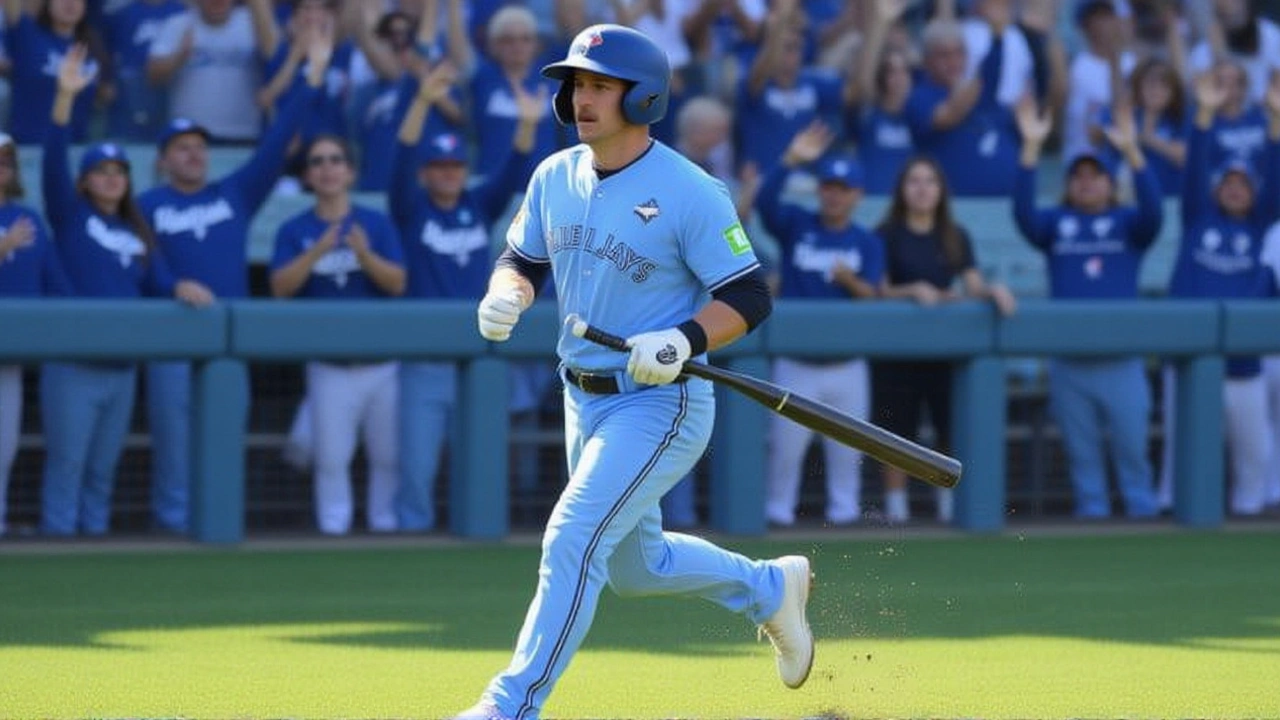
On October 29, 2025, at 8:07 PM Eastern Time, the 2025 World Series turned into a moment etched into baseball lore—not with a slow build, not with a dramatic comeback, but with two swings, two pitches, and a seismic shift in the game’s 119-year history. Vladimir Guerrero Jr., the Toronto Blue Jays’ 26-year-old slugger and son of Baseball Hall of Famer Vladimir Guerrero Sr., and Davis Schneider, a 25-year-old Canadian utility player who’d started just four postseason games, launched back-to-back home runs on the first two pitches of Game 5 at Dodger Stadium in Los Angeles. The result? The first time in World Series history a team opened a game with consecutive home runs. And it wasn’t just a fluke—it was a statement.
History in the First Three Pitches
Blake Snell, the two-time Cy Young Award winner and Dodgers’ ace, threw his first pitch—a 95.3 mph fastball—and Schneider, batting leadoff in place of the injured George Springer, crushed it 417 feet into the left-field bleachers. No one in the stadium blinked. Not even Snell. Then, on the next pitch, Guerrero Jr. didn’t just swing—he dismantled a 93.1 mph heater, sending it 402 feet down the left-field line. Two pitches. Two homers. Two runs. Zero outs. The crowd, usually electric at Dodger Stadium, fell silent. MLB’s historical database, which tracks every pitch since 1903, confirmed it: never before had this happened in a World Series game.
It wasn’t just unusual—it was unprecedented. Snell, who’d started 217 career MLB games, had never allowed two first-inning homers in the same game. And Schneider? He’d gone 3-for-16 in the playoffs. His last home run came in July. His manager, John Francis Schneider, had moved him into the leadoff spot because Springer’s hamstring injury had sidelined him since Game 3. The move was desperation, not strategy. It became genius.
Manoah’s Masterclass: From Underdog to Legend
The Blue Jays didn’t just rely on fireworks. They had a pitcher who turned pressure into poetry. Alek Manoah, the 27-year-old from Philadelphia, threw seven innings of one-run ball—three hits, nine strikeouts, zero walks. He didn’t just dominate—he redefined what a pitcher could do after a loss. In Game 4, Toronto had been blown out. In Game 5, Manoah didn’t just bounce back—he became the first pitcher in World Series history to throw seven+ scoreless innings with nine+ strikeouts after trailing by two or more runs in the previous game.
"That first game [Manoah pitched], you could just see, this is different," said Max Scherzer, the three-time Cy Young winner now with the Texas Rangers, analyzing the game for ESPN. "He can go up against anybody right now." Shortstop Bo Bichette, a four-time All-Star, added: "The maturity he's shown to handle these moments is really impressive."

The Next-Man-Up Philosophy
This wasn’t just about Guerrero Jr. and Schneider. It was about depth. The Blue Jays had hit 27 home runs in their first 16 playoff games—15 of them in the World Series alone. But the roster’s depth was what made them dangerous. Nate Pearson, the Canadian reliever, shut the door in the eighth. Addison Barger and Daulton Varsho provided timely hits. Andrés Giménez and Isiah Kiner-Falefa delivered a clutch RBI single in the fifth. The Blue Jays didn’t need one hero. They had a bench full of them.
"Blake established his fastball in Game 2 in Toronto, and we fully expected him to do the same tonight," said Dave Roberts, the Dodgers’ manager, after the game. "But they were just ready to hit fastballs from the very beginning."
Game 6: Home Soil, Historic Chance
The Blue Jays now lead the series 3-2. The decisive Game 6 is set for Thursday, October 31, 2025, at Rogers Centre in Toronto, with first pitch at 8:08 PM Eastern. Home-field advantage, a roaring crowd, and a chance to win their first World Series since 1993—this is what they’re playing for.
For Toronto, this isn’t just about breaking records. It’s about legacy. The team that was written off after losing Springer, the team that had to scramble for lineup solutions, is now one win away from glory. And it all started with two swings on two pitches—by two players who, just days ago, were considered role players.

What’s Next?
If the Blue Jays win Game 6, they’ll become the first Canadian team to win a World Series since the 1993 Toronto Blue Jays. If they lose? The series heads to a Game 7—back in Los Angeles—with the pressure on Snell and the Dodgers to survive one more night. But for now, the story belongs to Toronto: a team that didn’t wait for the moment to come to them. They created it.
Frequently Asked Questions
How did Davis Schneider, a player with a .188 postseason average, end up hitting the first home run of Game 5?
Schneider was moved into the leadoff spot because George Springer was sidelined by a hamstring injury since Game 3. Though he’d started only four of Toronto’s 15 postseason games and was 3-for-16 in the playoffs, manager John Francis Schneider trusted his contact skills and plate discipline. The decision paid off instantly—Schneider’s first-pitch homer was his first of the postseason, and it ignited the Blue Jays’ historic offensive outburst.
Has any team ever opened a World Series game with back-to-back home runs before?
No. In the 119-year history of the World Series since 1903, no team had ever hit back-to-back home runs on the first two pitches—or even the first two batters—of a game. MLB’s official database confirms this as a first. The closest prior occurrence was in the 1987 World Series, when the Twins hit consecutive homers in the first inning, but not on the very first pitches.
Why is Alek Manoah’s performance considered historic?
Manoah became the first pitcher in World Series history to throw seven+ innings with nine+ strikeouts after trailing by two or more runs in his previous start. He’d never before pitched past the sixth inning in any professional game. His ability to stay calm, command his fastball, and strike out five batters in a row under immense pressure turned him from a question mark into the game’s defining figure.
What does this mean for the Blue Jays’ chances in Game 6?
With home-field advantage at Rogers Centre and a 3-2 series lead, Toronto is now in the driver’s seat. The crowd will be electric, and the team’s momentum—fueled by power hitting and deep bullpen contributions—is at its peak. If they win, it’ll be their first title since 1993. If they lose, Game 7 returns to Los Angeles, where the Dodgers would have a chance to close it out on their home turf.
How does this compare to other historic World Series moments?
This start rivals the 1993 World Series when Joe Carter hit his walk-off home run to win it for Toronto. But this is different: it’s not a single hero—it’s a team. No team has ever opened a World Series game with back-to-back homers, and doing it against a Cy Young winner like Snell makes it even more remarkable. It’s a blend of timing, preparation, and sheer nerve that may never be repeated.
Who are the key players to watch in Game 6?
For Toronto, keep an eye on Vladimir Guerrero Jr.—he’s now 6-for-14 with 3 homers in the series—and Alek Manoah, who could be the starter if the Blue Jays go to Game 7. For the Dodgers, Clayton Kershaw is expected to pitch in relief if needed, and Mookie Betts will need to break out of his 2-for-15 slump. The game may come down to which bullpen holds up longer under pressure.

